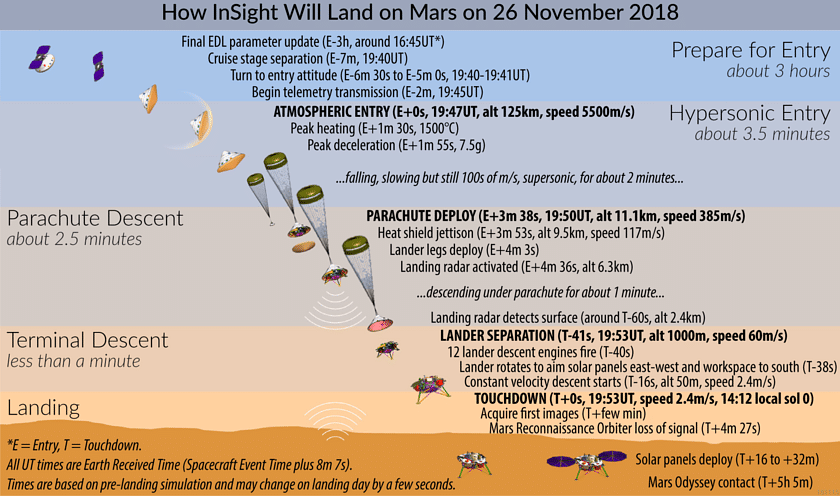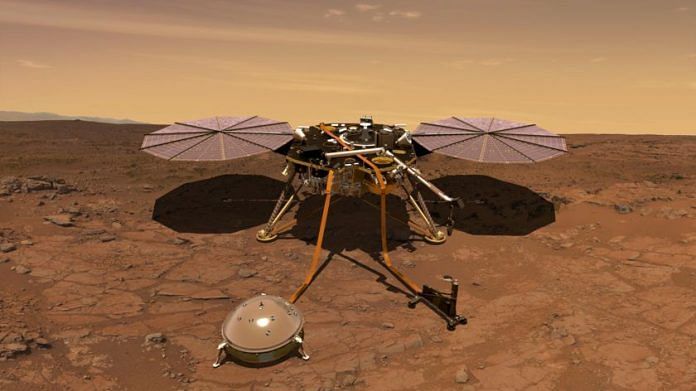NASA’s InSight is landing on Mars early Tuesday. Its mission is a seismic study of the red planet and assessment of its interior.
Bengaluru: US space agency NASA has a yet another craft landing on Mars early Tuesday.
The primary objective of InSight — short for Interior Exploration using Seismic Investigations, Geodesy and Heat Transport — is to study Mars’ interior and understand the formation of rocky planets in our solar system. To do this, the craft will deploy a seismometer upon landing.
This is yet another attempt by NASA to touch down on the red planet after the Curiosity rover landed in 2012.
Craft and payloads
The InSight lander, launched on 5 May, is expected to begin the landing procedure at 1:30 am IST Tuesday.
The Seismic Experiment for Interior Structure (SEIS) is a science instrument and will determine if there is any seismic activity at all in the interior of the planet. It will perform a deep tectonic study and assess the effect of meteorite impacts on Mars. This primary instrument will more accurately measure the thickness of the planet’s core and crust, improving the numbers we have today.
For this instrument alone, the entire mission is dubbed the ‘Mars seismological mission’. The seismometer will also detect tidal forces exerted by Mars on the moon Phobos.
The other science instrument on the mission is a heat probe, called Heat Flow and Physical Properties Package (HP3), which will also be placed upon Mars’s surface with a robotic arm. This probe is nicknamed ‘the mole’ as it is self-penetrating: Once placed on the surface, it can dig a hold as deep as 5 metres, gradually using a tether to descend and measure how heat is transferred under Mars’s surface and how it flows in the core.
There are two colour cameras and multiple other smaller instruments that will monitor weather and perform radio science experiments.
The craft is 6 metres wide and weighs a total of 694 kg. The lander itself weighs just 358 kg, of which the total payload mass is 50 kg. The craft is designed after the Phoenix lander.
Also read: Why two NASA space telescopes went offline in a week
The landing
With all interplanetary craft, the orbital insertion or landing are the most crucial and terrifying processes. Curiosity’s landing process was dubbed the “seven minutes of terror” and InSight will see a similar procedure as well.

The signal from Mars will be delayed by 8.1 minutes, and by the time we receive the first signal of landing process initiation, the entire thing would have been over on Mars.
The craft will first fire heaters and thrusters to slow down. The cruise stage which held solar panels for power will jettison and crash on the planet as the craft switches temporarily to battery power. The lander will then reorient itself and enter Martian atmosphere, with the heat shield taking the brunt of it.
Once it has slowed down enough, parachutes will be deployed and the heat shield jettisoned. Then the lander legs will deploy, after which the lander will immediately separate from its shell and touch down on the ground. Along the way, we will obtain images and signals from other craft that are buzzing around the planet currently.
The entire process will take 6.45 minutes, after which the solar panels will deploy on surface and the two cameras will start clicking images to send back to Earth.
The landing will take place on a giant volcanic plain called Elysium Planitia — Curiosity is currently to the north of this location. The site was chosen for two primary reasons. One, the lander will land on its three feet and to prevent mishaps, a flat surface would be helpful. Secondly, since the lander will not move upon touchdown (unlike a rover), it was important to land in a place where science experiments could be performed at ease.
Since one instrument is intended to dig and study heat transfer, a warm and sunny region was needed, which also doubles up as a way to ensure that the lander’s solar panels are amply basking.
The lander is expected to function for at least two years on the red planet.
Also read: When NASA probe kisses the Sun, a star will spill long-held secrets



